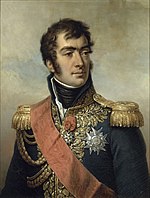
The Battle of Elchingen, fought on 14 October 1805, saw French forces under Michel Ney rout an Austrian corps led by Johann Sigismund Riesch. This defeat led to a large part of the Austrian army being invested in the fortress of Ulm by the army of Emperor Napoleon Bonaparte of France while other formations fled to the east. Soon afterward, the Austrians trapped in Ulm surrendered and the French mopped up most of the remaining Austrian forces, bringing the Ulm Campaign to a close.
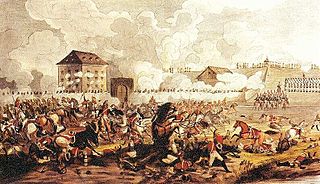
The Battle of Raab or Battle of Győr was fought on 14 June 1809 during the Napoleonic Wars, between Franco-Italian forces and Habsburg forces. The battle was fought near Győr (Raab), Kingdom of Hungary, and ended in a Franco-Italian victory. The victory prevented Archduke John of Austria from bringing any significant force to the Battle of Wagram, while Prince Eugène de Beauharnais's force was able to link up with Emperor Napoleon at Vienna in time to fight at Wagram. Napoleon referred to the battle as "a granddaughter of Marengo and Friedland", as it fell on the anniversary of those two battles.
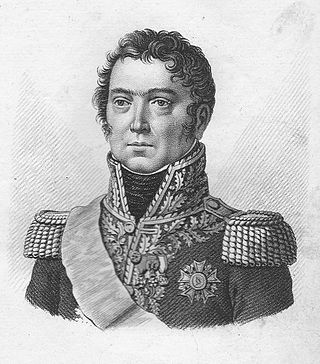
Count Paul Grenier joined the French royal army and rapidly rose to general officer rank during the French Revolutionary Wars. He led a division in the 1796-1797 campaign in southern Germany. During the 1800 campaign in the Electorate of Bavaria he was a wing commander. Beginning in 1809, in the Napoleonic Wars, Emperor Napoleon I entrusted him with corps commands in the Italian theater. A skilled tactician, he was one of the veteran generals who made the Napoleonic armies such a formidable foe to the other European powers. After the Bourbon Restoration he retired from the army and later went into politics. Grenier is one of the Names inscribed under the Arc de Triomphe.

Baron Franjo Jelačić Bužimski was a Croatian military officer and nobleman, a member of the House of Jelačić. He began his service in the Habsburg army as a Grenz infantry officer and fought against the Ottoman Turks. During the French Revolutionary Wars he received promotion to the rank of general officer and won an outstanding victory at Feldkirch. His later career proved that his martial abilities were limited. He twice led independent division-sized forces in the Napoleonic Wars, with unhappy results. He was Proprietor (Inhaber) of an Austrian infantry regiment from 1802 until his death.
In the Battle of Sankt Michael on 25 May 1809, Paul Grenier's French corps crushed Franz Jellacic's Austrian division at Sankt Michael in Obersteiermark, Austria. The action occurred after the initial French victories during the War of the Fifth Coalition, part of the Napoleonic Wars. Sankt Michael is located approximately 140 kilometers southwest of Vienna.

The Battle of Graz took place on 24–26 June 1809 between an Austrian corps commanded by Ignaz Gyulai and a French division led by Jean-Baptiste Broussier. The French were soon reinforced by a corps under Auguste Marmont. The battle is considered a French victory though Gyulai was successful in getting supplies to the Austrian garrison of Graz before the two French forces drove him away from the city. Graz, Austria is located 145 kilometers south-southwest of Vienna at the intersection of the modern A2 and A9 highways.

The Battle of Abensberg was fought on 20 April 1809, between an Allied force under the command of Emperor Napoleon I of France on one side and three Austrian corps led by Johann von Hiller, Archduke Louis of Austria, and Michael von Kienmayer. The Austrians formed the left wing of Archduke Charles, Duke of Teschen's main army and were under the overall command of Hiller. Napoleon's French troops, reinforced by troops from the Kingdom of Bavaria and the Kingdom of Württemberg outfought their opponents, inflicted heavy losses, and forced the Austrians to retreat to the southeast.

The Battle of Neumarkt-Sankt Veit on 24 April 1809 saw a Franco-Bavarian force led by Marshal Jean-Baptiste Bessières face an Austrian Empire army commanded by Johann von Hiller. Hiller's numerically superior force won a victory over the Allied troops, forcing Bessières to retreat to the west. Neumarkt-Sankt Veit is located ten kilometers north of Mühldorf and 33 kilometers southeast of Landshut in Bavaria.
The Battle of Sacile saw the Franco-Italian Army of Italy commanded by Eugène de Beauharnais face the Archduke John of Austria's Army of Inner Austria during the War of the Fifth Coalition. Believing that he was only opposed by the Austrian VIII Armeekorps, Eugène launched his right wing in a heavy attack against it. In the morning, the Austrians successfully held off Franco-Italian assaults on their left flank as Eugène reinforced the attack with troops from his left wing. Later in the day, John counterattacked Eugène's weakened left wing with the IX Armeekorps, forcing the Franco-Italian army to withdraw from the battlefield. The battle at Sacile was preceded by the action of Pordenone on 15 April in which the Austrian advance guard mauled the French rear guard. The Austrian victory compelled Eugène to retreat to the Adige River at Verona where he gathered reinforcements and planned a counteroffensive.
Joseph-Armand Ritter von Nordmann, was a French officer in the French Royal Army. He transferred his allegiance to Habsburg Austria during the French Revolution, like other French émigrés. In Austrian service he fought capably against his former country during the French Revolutionary Wars and the Napoleonic Wars.

Konstantin Ghilian Karl d'Aspré von Hoobreuk, served in the army of Habsburg Austria during the French Revolutionary Wars. In the Napoleonic Wars, he made a mark in two major campaigns. In 1809, he was briefly Proprietor (Inhaber) of an infantry regiment and rose to command a division. His son Konstantin d'Aspré (1789–1850) also became an Austrian general.

The Battle of Tarvis from 16 to 17 May 1809, the Storming of the Malborghetto Blockhouse from 15 to 17 May 1809, and the Storming of the Predil Blockhouse from 15 to 18 May saw the Franco-Italian army of Eugène de Beauharnais attacking Austrian Empire forces under Albert Gyulai. Eugène crushed Gyulai's division in a pitched battle near Tarvisio, then an Austrian town known as Tarvis. At nearby Malborghetto Valbruna and Predil Pass, small garrisons of Grenz infantry heroically defended two forts before being overwhelmed by sheer numbers. The Franco-Italian capture of the key mountain passes allowed their forces to invade Austrian Kärnten during the War of the Fifth Coalition. Tarvisio is located in far northeast Italy, near the borders of both Austria and Slovenia.

Peter, Freiherr von Vécsey or Peter Vécsey de Hernádvécse et Hajnácskeő was an Imperial Austrian military commander of Hungarian descent who took part in the French Revolutionary Wars and Napoleonic Wars. As a Freiherr (Baron), he was a member of the Austrian landless nobility. He make his mark while leading cavalry units and advanced in rank to become a general officer in 1808. He led an independent brigade during part of the 1809 campaign, and was mortally wounded while leading his troops in battle.
Karl Daniel Gottfried Wilhelm von Stutterheim, born 6 August 1770 – died 13 December 1811, served in the Prussian and Saxon armies during the French Revolutionary Wars, leaving the latter service in 1798. He spent most of his career in the army of Habsburg Austria and the Austrian Empire. He commanded a brigade in combat against the First French Empire during the 1805 and 1809 wars. In the latter conflict, he led his troops with dash and competence. He authored two histories about the wars; the second work remained unfinished due to his suicide in 1811.
The Battle of Linz-Urfahr on 17 May 1809 saw soldiers from the Austrian Empire fighting against troops from two of Emperor Napoleon's allies, the Kingdom of Württemberg and the Kingdom of Saxony. An Austrian corps led by Feldzeugmeister Johann Kollowrat attacked General of Division Dominique Vandamme's Württembergers who held a fortified bridgehead on the north bank of the Danube opposite the city of Linz. As the combat got underway, Saxons led by Marshal Jean-Baptiste Bernadotte began reinforcing the defenders. This prompted Kollowrat to order a retreat, which was followed up by Napoleon's German allies.
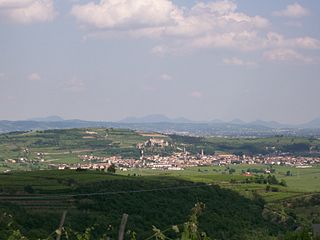
In the Battle of Caldiero or Battle of Soave or Battle of Castelcerino from 27 to 30 April 1809, an Austrian army led by Archduke John of Austria defended against a Franco-Italian army headed by Eugène de Beauharnais, the Viceroy of the Kingdom of Italy. The outnumbered Austrians successfully fended off the attacks of their enemies in actions at San Bonifacio, Soave, and Castelcerino before retreating to the east. The clash occurred during the War of the Fifth Coalition, part of the Napoleonic Wars.
The Piave River 1809 order of battle shows the units and organization for the Franco-Italian and Austrian Empire armies that fought in the Battle of Piave River on 8 May 1809. Eugène de Beauharnais, the viceroy of the Kingdom of Italy defeated Archduke John of Austria. Eugène's Advance Guard crossed the river first and was assailed by Austrian cavalry and artillery. The French cavalry routed the opposing cavalry and captured 14 enemy guns. A lull followed as John arranged his infantry in a formidable defensive position. Meanwhile, Eugène struggled to pour reinforcements into the bridgehead as the Piave rose dangerously. In the afternoon, the viceroy sent Paul Grenier to drive back the Austrian left while Jacques MacDonald mounted an assault on the center. The attack succeeded in breaking the Austrian line and compelling John to order a retreat.

August, Graf von Vécsey or August Vécsey de Hernádvécse et Hajnácskeő was an Imperial Austrian general of Hungarian descent who fought in the French Revolutionary Wars and Napoleonic Wars. He won a notable award in 1806 and became a general officer in 1809. That year, he commanded a brigade at Wagram during the War of the Fifth Coalition. His brigade was defeated by superior numbers at Feistritz in September 1813. He led his troops during the subsequent Italian campaign in 1813 and 1814. He was promoted to higher rank in 1820 and 1840.
Paul von Radivojevich was an Austrian army corps commander in the army of the Austrian Empire during the late Napoleonic Wars. He joined the army of the Habsburg monarchy in 1782 and fought in one of the early battles of the French Revolutionary Wars. He led a Grenz Infantry Regiment before being promoted to general officer in 1807. He led a brigade at Eckmühl in 1809, a division in the summer of 1813, and a corps at Caldiero in 1813 and at the Mincio in 1814. During the 1815 Italian campaign, he led a corps in Switzerland, Piedmont, and France. After the wars, he commanded part of the Military Frontier. He was Proprietor (Inhaber) of an infantry regiment from 1815 until his death in 1829.
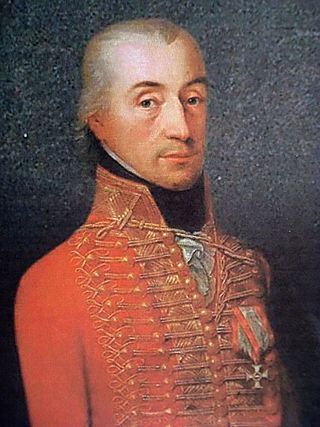
Vinko Knežević or Vincent Knesevich of Saint Helen ; 30 November 1755 – 11 March 1832) was a Croatian nobleman and general in the Habsburg monarchy imperial army service. He was a member of the Knežević noble family. During his long military career he fought in many battles during the Austro-Turkish War and the French Revolutionary Wars. In 1799 he led a hussar regiment at Cassano, the Trebbia and Novi. He commanded an infantry brigade at Marengo the following year and led Austrian Empire troops in the Tyrol in 1805 and at Graz in 1809. He served in various assignments on the Military Border from 1809 to 1812. From 1802 he lived on his estate Sveta Jelena in former Zala County, modern-day Međimurje County in northern Croatia. By the end of Napoleonic Wars he retired from military service as a General der Kavallerie in 1815. He became Proprietor of a dragoon regiment in 1809 and held that office until his death in 1832.
